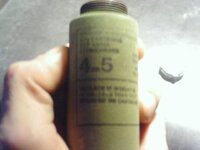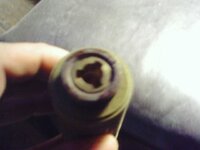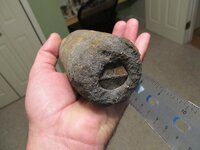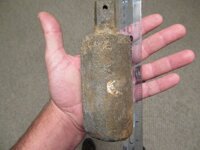Ifoundit69
Saving the past one find at a time !
- Dec 5, 2007
- 1,251
- 600
- 🥇 Banner finds
- 1
- Detector(s) used
- Whites Spectrum Xlt ,Fisher 1270, Fisher F5 ,Fisher F2, , Ctx 3030 ,Nokta Anfibio,Minelab Safari
- Primary Interest:
- All Treasure Hunting
dynamite blasting cap ? Need a ID "solved"
Found a new site today ,nice stone foundation ,celar hole is huge hasnt been touch . Large and deep rock quarry about 200 feet away . As I was walking around surveying my new spot I saw this laying on the ground the outside is rock no doubt about it and the inside peice in quessing copper not sure but has a hole in the center and a little of some kind of corrosive material coming out of the hole . I was thinking blasting cap or something along those lines maybe one that didnt detonate or something ... Any help with this is greatly appreciatted !!!!!
Found a new site today ,nice stone foundation ,celar hole is huge hasnt been touch . Large and deep rock quarry about 200 feet away . As I was walking around surveying my new spot I saw this laying on the ground the outside is rock no doubt about it and the inside peice in quessing copper not sure but has a hole in the center and a little of some kind of corrosive material coming out of the hole . I was thinking blasting cap or something along those lines maybe one that didnt detonate or something ... Any help with this is greatly appreciatted !!!!!















![battery_encarta[1].JPG](/data/attachments/582/582312-f43bafab1e703daf7bfd14441eed8fe0.jpg)
![24090-004-EC128E8C[1].gif](/data/attachments/582/582308-41dbfc54f037ec9700e306dd43ceee32.jpg)
![Battery[1].jpg](/data/attachments/582/582279-e79ce2d2704ab0e9b306e40c208c9c47.jpg)
![robert-bunsen-inventions-dry-cell-zinc-carbon-battery_34001_600x450[1].jpg](/data/attachments/582/582316-eae9a11d7d22ba303bc49af92d29dd1a.jpg)

